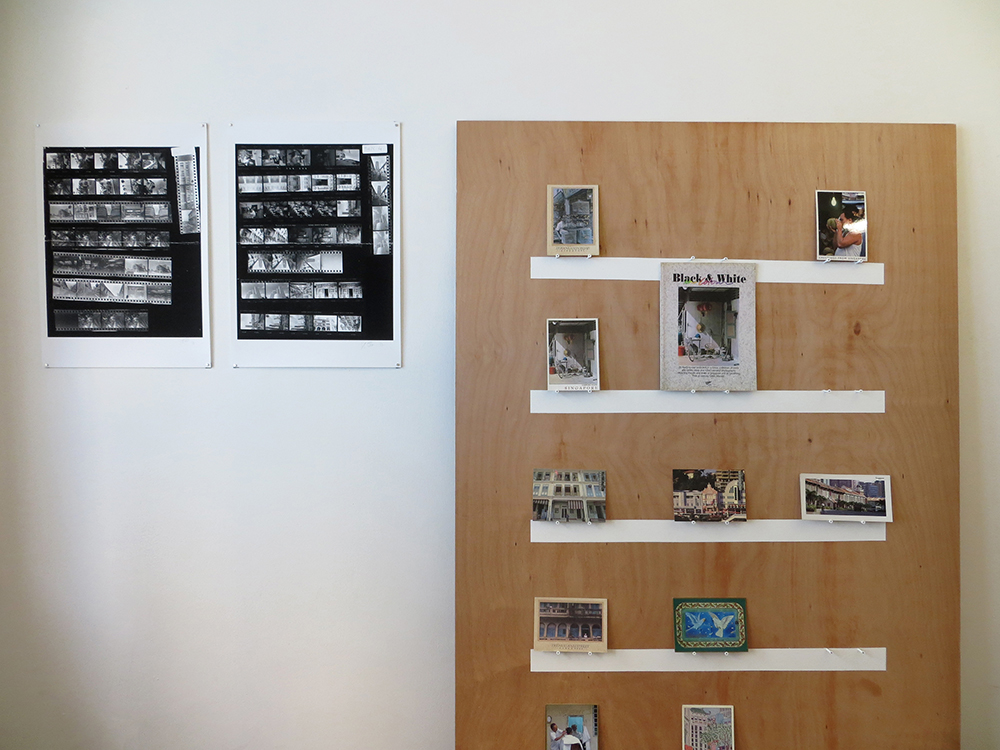Tints & Dispositions by Gilles Massot [2017]
[18.03.17 — 20.04.17]
Grey Projects is pleased to present Tints & Dispositions, an exhibition of prints and photographic material from the studio archives of Gilles Massot. This project is a first for Grey Projects, it launches an exhibition and curatorial program that focuses on historicising the making of recent art and our understanding of the contemporary in Singapore and Asia. Tints & Dispositions is a 'first' in another regard - it re-contextualises the first exhibition that Massot staged in Singapore in 1985.
“Massot arrived in Singapore in 1981 to work in advertising but very quickly moved on to personal, photographic endeavours, beginning a series of travel, editorial and documentary assignments that continued for two decades into the present millennia. In 1984, Massot started shooting in black and white and slide film, some of the early contact prints are included in this exhibition. These images form the substrate of history and territory behind Massot's painted prints. Before our current valorisation of heritage reuse, interdisciplinary activity and independent initiatives, Massot exhibited these painted images in a flatted factory block in Macpherson, for a one-night-only party and exhibition Massot called BW2C, Black and White to Color.
With the prepositional 'to' in Massot's nomenclature, Massot suggests what is quickly apparent from a survey of the work - a shift away from the strictly photographic, and away from modernist preoccupations with genre, discipline and taxonomy. As the project accumulated images, other movements can be observed: the circling and return to neighbourhoods in the city centre now encompass estates further up the river and inland; the surveying eye of the guest replaced by the intimacy of the inhabitant as Massot's subjectivity too shifted, from a transient journeyman to resident to an inhabitant with a justifiably deeper citizenry to this place than most.
This preposition inaugurates the first of many departures for Massot. What was initially a farewell party in 1985 became one of many moments of farewell and return, and while he initially hand tinted his images to reflect, in his words, 'the 'ongoing shrinking, disappearing pockets' of colourful traditions, he soon abandoned these forms in favour of paint that foregoes respect for the naturalistic composition of the existing surface. Instead, this layer, with its strongly foregrounded patterning, outré colours and expressionist washes, impinges upon the existing everyday surface, pressing that into service as a backdrop upon which another situation is enacted, the way a loud though not unwelcomed intruder might in a given scene.
This departure from naturalism towards the crude and unnatural is perhaps the crux of the show, that is, these marks of deliberately unnatural expressiveness are implicitly queer, their intrusion in these images of everyday sociality and commerce an introduction of a playful alterity. Massot never completely abandoned the relatively straightforward capture of urban development, as his many series of postcards attest. Yet, aware of the metonymic power old places have as ‘authentic Singapore’, Massot in these images offer us something else. Other than the nostalgic appreciation of place, the paintings suggest a liveliness of a different order - pattern without symmetry, repetition without principle. In this way, I read Massot's departures as a claim of queer belonging, a painterly insistence laid upon the image of history and territory that he lived through and inhabits, for us to examine our notions of citizenship. In this reading, his circling meanderings into the island becomes his migration into that much-disputed 'heartland'. If this island is in possession of an imagined community, then, to use Cindy Patton's clever augmentation, we are a community of many nations, overlapping and spawning new and more colourful permutations. Behind his preposition is a distinctly queer disposition.” — Jason Wee
—
Gilles Massot is a multidisciplinary artist and academic whose work based on the idea of “the space between things” aims to establish links and decipher the narratives existing between disciplines, people, occurrences and parts of the world. His visual art practice more specifically deals with the theory of photography and its relation to time and space.
After studying architecture and photography in Marseille, he came to live in Singapore in 1981. His early participation to the local art scene saw him involved in a string of seminal art events, including the first editions of the Festival of Arts Fringe and the 1987 Yin Yang Festival. In the 1990s he travelled extensively across Asia and Europe, a way of living that resulted in over fifty exhibitions, and an extensive body of editorial work published in diverse magazines in Asia and Europe.
With the new century his focus shifted onto academia and research. His book Bintan, Phoenix of the Malay Archipelago (2003) had a profound influence on his artistic process, since then often dealing with history and ethnology in the form of mix-media works. This was followed in 2006 by an MA-FA dealing with the apparition of the photographic idea in the 18th century in relation to the notion of “image” as found in the English garden. He recently completed a research on Jules Itier who did the first daguerreotypes of China, Philippines, Sri Lanka, Singapore and Vietnam in 1844 - 45.
He currently lives in Singapore where he teaches in LASALLE College of the Arts. His work is part of the LTA Integrated Art Program (Buona Vista Station), the Singapore Art Museum and the Maison Européenne de la Photographie in Paris among other collections. He is a recipient of the French cultural award Chevalier des Arts et des Lettres.





